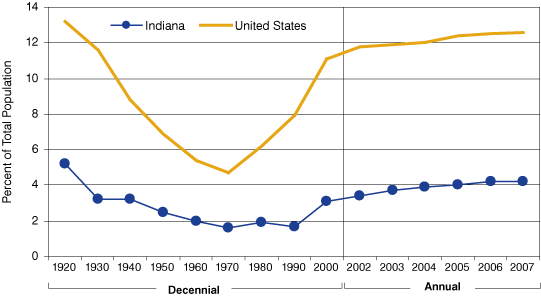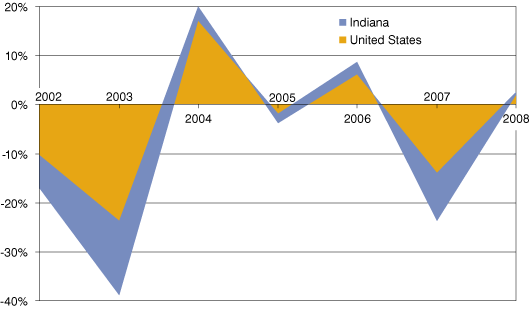The Latest on Indiana's Foreign-Born Population
Today, people from all over the world live in Indiana, with five in every 100 people hailing from another country. The foreign-born population in Indiana is larger than the population of Fort Wayne, our second largest city (at 252,000). Of the 264,000 people who were born in countries other than the United States (and not U.S. citizens born overseas), the majority have come to Indiana from Latin America (49.4 percent), Asia (25 percent) and Europe (17.4 percent).
By 2007, Indiana's proportion of foreign-born residents was less than half that of the nation's 12.6 percent. Indiana's proportion ranks it at 35th among the 50 states and the District of Columbia. But, when we consider the percent of our population by specific region of the world, our percentages are similar to that of the nation. In the case of people born in Mexico and now living in Indiana, we have a proportion (39.8 percent) that is nearly 10 percent higher than the nation as a whole and ranks Indiana 16th among the states. Indiana also tends to attract more people (proportionally) from Europe, with a percentage more than 4 points higher than the nation (see Table 1).
Table 1: Foreign-Born Population in Indiana and the United States
| Percent of the Population That Is Foreign Born | Total |
Asia | Europe | Latin America | Latin America: Mexico |
| United States | 12.6 | 26.8 | 13.1 | 53.6 | 30.8 |
| Indiana | 4.2 | 25.0 | 17.4 | 49.4 | 39.8 |
| Number of States Above U.S. Percentage | 12 | 27 | 33 | 16 | 24 |
| Number of States Above Indiana Percentage | 35 | 30 | 24 | 20 | 15 |
Source: U.S. Census Bureau, 2007 American Community Survey
Historically, Indiana has had intermittent highs and lows in its foreign population.1 Based on the results of the 1920 Census, which showed huge numbers of immigrants to the United States, more than 5 percent of Indiana's population had been foreign born. That proportion fluctuated significantly over the decades, with a low of 1.7 percent in 1990 (compared to 7.9 percent nationally) that has been followed by continuous increases ever since (see Figure 1).
Figure 1: Foreign-Born as a Percent of Total Population for Indiana and the United States, 1920-2007

Source: IBRC, using data from the U.S. Census Bureau's decennial census and American Community Survey
After a 7 percent decrease in the foreign-born population between 1980 and 1990, immigration to Indiana has shown consistent increases since the 2000 census.
Immigration to Indiana tends to mirror national trends and major influences are economic and social. When jobs have been numerous and the economy strong, immigration is on the upswing. As more people move to the United States and establish roots, family members tend to follow and swell the ranks of the foreign born. Historically, when the economy is down, so is immigration (see Figure 2).
Figure 2: Change in Net International Migration for Indiana and the United States, 2002-2008

Source: IBRC, using data from the U.S. Census Bureau's annual population estimates
Considering the current recession, one of the longest running since the 1930s, we may see short-term declines in the numbers of people coming to Indiana from other countries. For more information, be sure to track these and other trends on STATS Indiana (www.stats.indiana.edu) and at the U.S. Census Bureau (www.census.gov).
Notes
- Campbell J. Gibson and Emily Lennon, "Historical Census Statistics on the Foreign-born Population of the United States: 1850-1990," Population Division Working Paper No. 29, U.S. Census Bureau, www.census.gov/library/working-papers/1999/demo/POP-twps0029.html.
Carol O. Rogers
Deputy Director and Chief Information Officer, Indiana Business Research Center, Indiana University's Kelley School of Business
